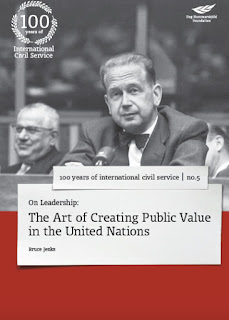“The push and pull between a body of sovereign states and ‘we the peoples’ is one of the defining characteristics of what the UN is,” writes BRUCE JENKS in a paper published by the Dag Hammarskjold Foundation.
Looking at what leadership means in the highly complex environment in which the United Nations operates, he explores the underlying principles of international public service as articulated in articles 97-101 of the UN Charter, as well as the interpretation of these articles by Dag Hammarskjold in his May 1961 Oxford Speech. Together these provide insights into the political space which can influence the scope for initiative and leadership, JENKS contends in his paper, ‘On Leadership: The Art of Creating Public Value in the United Nations’, published as part of the Foundation’s series commemorating 100 years of the international civil service.
JENKS also explores how Mark Moore’s strategic triangle serves to identify the scope of the political space that lies at the heart of the art of leadership. He discusses a number of the instruments available to create, as well as to invest in, political space.
The author concludes by highlighting that our reflections on the 100th anniversary of the creation of the international civil service come at a unique moment. “The need for strategic capacity and political space has never been so evident as it is today.” This is because of the convergence of a number of critical elements.
“The arrival of Anthropocene man means that for the first time, human beings have a direct impact on their own destiny,” JENKS states. “The speed of technological and scientific innovation is daunting. Today, never has the gap been so big between the resources we have at our disposal, what we can do with them, and what we are actually doing.”
Development challenges are emerging that require a collective response if there is to be any chance of finding solutions, the author states, adding that effective decision-making requires a level of collective action to succeed. Multilateralism has a major role to play in this regard. And the scientific evidence points to the very limited time we have to undertake the transformative changes which are required.
“The challenge that is common to all of these dimensions relates to the choices we make,” JENKS writes. “How do we exercise the control we have, how do we translate our mission into reality and how do we choose to use and create value out of the resources that are so bountiful.”
Fortunately, he states, Agenda 2030 provides us with a powerful, universal mission statement. “Whether its rhetoric will be matched by its translation into reality remains to be seen.”





No comments:
Post a Comment